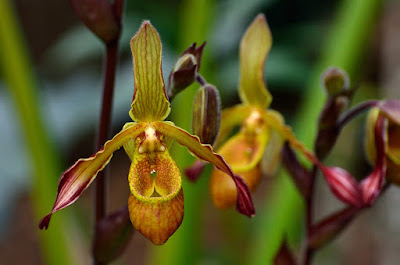Phragmipedium lindleyanum occurs in Venezuela, Guyana, Suriname, French Guiana and Brazil. It is found in wet meadows, in wet root mats in secondary forests, clinging to rocks along streams and seeps, and in the splash zones of waterfalls between 1000-2200 meters above sea level, although it may be found at lower elevations of 600 m above sea level in very cool and wet conditions.
Phragmipedium lindleyanum also called as Lindley's Phragmipedium, Cypripedium lindleyanum, Paphiopedilum lindleyanum, Phragmopedilum lindleyanum, Selenipedium lindleyanum, is a species of the genus Phragmipedium. This species was described by Robert Allen Rolfe in 1896.
IDENTIFY PHRAGMIPEDIUM LINDLEYANUM ORCHID PLANT
Phragmipedium lindleyanum occurs in Venezuela, Guyana, Suriname, French Guiana and Brazil. It is found in wet meadows, in wet root mats in secondary forests, clinging to rocks along streams and seeps, and in the splash zones of waterfalls between 1000-2200 meters above sea level, although it may be found at lower elevations of 600 meters above sea level in very cool and wet conditions.
It is a large sized, cool to warm growing terrestrial or lithophyte with no pseudobulbs, occuring in moist areas near waterfalls or seepage areas with very short stems carrying to 4 to 7, linear-lanceolate, suberect, fairly rigid, acuminate, 30-110 cm long, 3-8 cm wide leaves.
Lindley's Phragmipedium blooms on a 90 to 120 cm long, stiffly erect, pubescent, green, rachis reddish, with a few to several, sequentially single flowered inflorescence arising along the length of the main stem with many large, loose, acuminate floral bracts occuring in the fall through early spring. The flowers are 7-9 cm wide, yellow- to olive-green suffused with reddish-brown.
PHRAGMIPEDIUM LINDLEYANUM ORCHID PLANT CARE AND CULTURE
Cultural information should only be used as a guide, and should be to be adapted to suit you. Your physical location; where you grow your plants, how much time you have to devote to their care, and many other factors, will need to be taken into account. Only then can you decide on the cultural methods that best suit you and your plants.
Light:
Phragmipedium lindleyanum require medium to bright light (30000-70000 lux). It must be kept out of direct sunlight. It like more light in winter. It will grow in lower light but are much slower growing and will tend to climb more. Flower colour is also more intense when grown in bright light. Young seedling plants are reported to require less light.
Temperature:
It is an intermediate temperature plant with the optimum minimum temperature being about 10°C. The maximum temperature should ideally not exceed 30°C but higher temperatures up to 40°C will be tolerated for short periods if humidity is raised by misting or other techniques and good airflow is maintained with a fan if necessary. If daytime temperatures are above 35- 40°C the light level should be reduced further with additional shading or plants placed down low in the shade house.
Humidity:
Lindley's Phragmipedium like high humidity preferably above 50%. Good air movement should be ensured. Growths that do not dry out by evening can get bacterial rot. Fans may be required to aid air movement if fungal or bacterial diseases are a problem.
Substrate, growing media and repotting:
Phragmipedium lindleyanum are best grown in deeper nursery shaped pots rather than squat pots. The potting mix contains a standard seedling grade 5-10mm bark mix containing perlite and sometimes coarse river sand and vermiculite.
It is recommend to repotting every year, to every year and a half. Keep the pot size as small as possible, just large enough to accommodate the roots. Trim any damaged or dead roots and let the potting mix fall away. If the plant is root bound, no further trimming is necessary, just pot into a slightly larger pot.
Watering:
These plants should be kept moist year round with frequent watering and not allowed to dry out. Plants can be kept a little drier in winter. Some growers stand the pots in shallow trays containing water about 2cm deep in warmer weather. In summer plants can be watered every 2 to 3 days in hot weather but in winter they may require watering only every 7-14 days depending on the potting mix and weather conditions.
Fertilizer:
It is recommended to applying a 20-20-20 or similar balanced fertilizer once every 2 to 3 weeks. Less fertilizer should be used in winter. Some growers suggest high phosphorus fertilizer in autumn encourages flower development but others actively discourage it.















COMMENTS